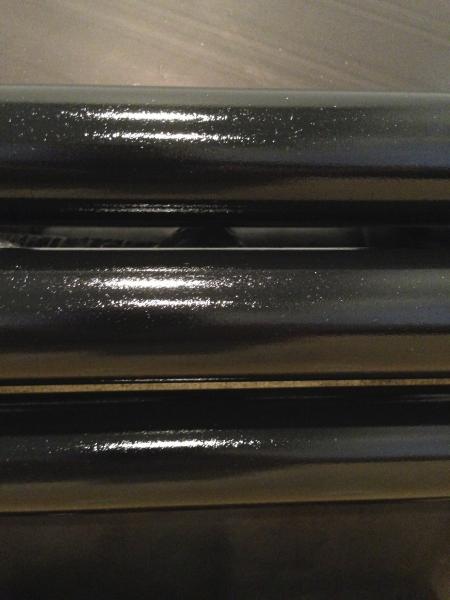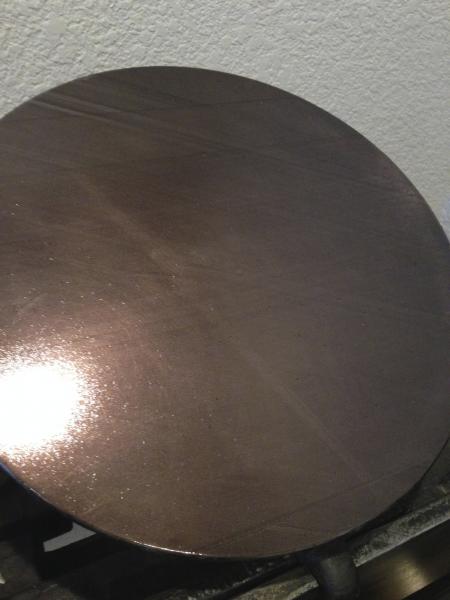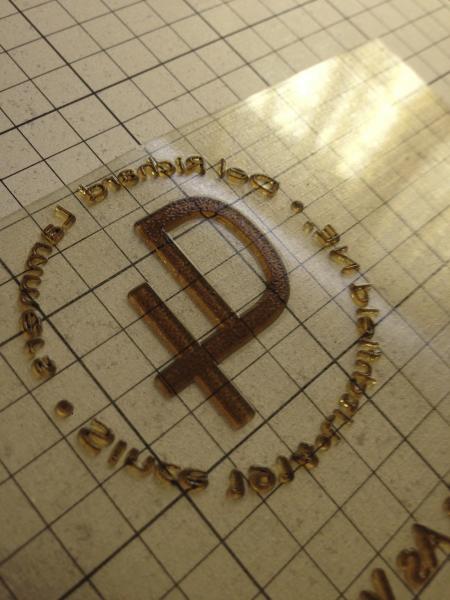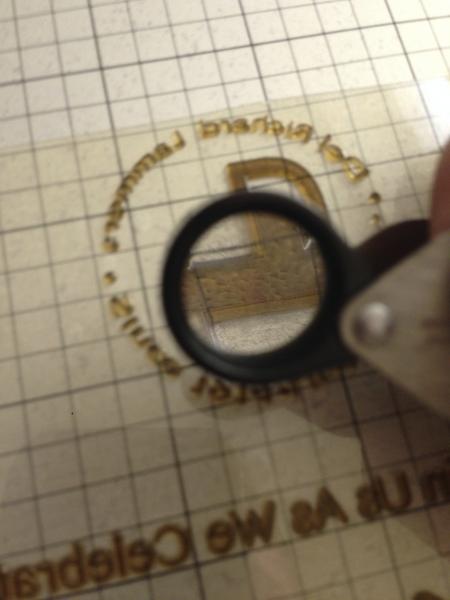Trouble with first prints
Well my wife and I are trying to get a new hobby underway and it is not turning out so good right now. I love machines and she loves to send out cards, so what better way to spend our time huh? So far it has caused nothing but frustration and has not made the best QUALITY time. We have not had a chance to go to a Workshop yet on the matter so our experience is limited internet research and books like, General Printing, Elementary Platen Presswork, and the Practice of Printing. So here is the long story and many pictures. Ill start with a list of what im working with:
- Chandler and Price 1926 NS 8x12 press. Cleaned and lubed, runs smoothly. I have a kimble direct drive motor that I will hook up later once we get proficient. I leveled the platen with some squares of metal I locked up in the corners of the chase and used soft lead solder to measure the distance of the platen to my .918 blocks. I set it at .050 offset. I got this from a previous discussion on the matter.
- Chandler and Price 1946 26 ½” guillotine cutter. Just had the blade sharpened. took apart all moving pieces, cleanded lubed and adjusted blade to kiss the new plastic strip. Finally figured out the need to use chipboard and to back cut on Lettra.
- Boxcar 6x9 standard relieve base and plate
- Van Sons Rubber Based ink mixed to Pantone 407U
- Tympan starter set from Excelsior Press
- Crane Lettra 300gsm Ecru paper
- New Rollers, Cores, and Delrin Trucks from Ramco
- Boxcar lollipop gauge
So we installed 2 of the rollers on the machine and added about a pea size dab of ink on the plate and I spread it across and proceeded to turn the press until it was uniform on the disk and rollers. I knew the rails were about .035 under type high from previous measurements so I added strips of UHMW tape to each side until we got around 3/32 strip on the lollipop gauge
we set up the boxcar base in the chase and used our quartz counter top to lock up the base using furniture and hi-speed quoins. All seemed to lock up well and noticed no spring. Before doing any work the chase has a slight bow in the sides of it but a all the corners sit flat. It looked the same after lockup and the base was sitting flat on the counter. A granite surface plate is in the plans. Installed the chase in the press.
We set up tympan paper and some packing in the press. Took the rollers off the press to avoid inking . set up Henry compressible gauges on the Tympan, put a piece of double sided tape on the plate and aligned it on the Lettra stock. Ran the press to transfer the plate to the base.
Put in rollers , inked the plate and adjusted the packing until I got a slight impression all over paper. It was not very crisp though. We noticed a lot of bleeding on the sides. We saw that the rollers were skidding at points due to the slick surface of the tape. We replaced the top tape with some masking tape to give some bite. Rechecked the lollipop gage and continued on. We were never able to get a nice inked impression for what we though we should be able to get. We tried different packing, more impression, less impression, more ink, less ink. The rollers and ink plate have an orange peel appearance. When it is transferred to the plate you can see the orange peel on the plate too. I do not really know what Im looking for on the ink really. I figured it would be nice and smooth. We did notice some inking on the beards that should be telling me I need to raise my rollers. I added another .003 layer of tape and then it did not ink at all. Im not for sure about my roller springs but I don’t know why they would have so much compression in a static state.
Im going to clean off the press and reset to zero but I really don’t know what to do different. I suspect it is mostly ink related but know nothing really about it.
Here are pics. ETA, can image tags [img] be used from a server like photobucket so i dont have to deal with the attached uploader?
[URL=http://s25.photobucket.com/user/machinehead323/media/IMG_1022.jpg.html][IMG]http://i25.photobucket.com/albums/c51/machinehead323/IMG_1022.jpg[/IMG][/URL]

IMG1002.jpg

IMG1003.jpg

IMG1004.jpg

IMG1005.jpg

IMG1007.jpg

IMG1008.jpg

IMG1018.jpg

IMG1022.jpg
Very good and very detailed description of what you have done so far, and the results. This helps the wizards who attempt long distance diagnosis and assistance. Nothing works as well as seeing the actual patient, but we will try to assist.
No amount of arm waving and cursing will do any good. The inking has to be right before you can go any further.
Poly plates are fussy. Also rubber base ink hates ANY oil.
Even oil from your skin.
I suggest you clean your plate with alcohol. The advantage is that it contains no petroleum product and it dries quickly. It also appears that you have too much ink. The orange peel is evidence of that. Too much ink is common with new printers. Use ear and eye to gauge the correct amount. This assumes decent hearing (mine no longer is decent) The press will sing with a light hiss when the ink is correct. A sizzle means too much. Look at the bottom part of the ink disk just as the rollers leave it on the upbound pass. I call the texture light velvet. Orange peel is too much.
Clean the plate and ink the press correctly. Then put the chase in and ink the plate. Remove chase and inspect plate for a uniform inking. Insure that only the face of the characters is inked. Any ink down the beard is bad.
I think you are close.
Get some ink on your shirt.
Inky, Well from your post I have some stuff to change. Before I inked up the press I cleaned off the ink plate and poly plate with mineral spirits. I was also cleaned the poly off a couple times with mineral spirits to get the ink out of the beards. So I will clean off the press real good and do a final clean with alcohol to remove all traces of petroleum. With the instructions I got with my Ramco rollers it says to use a water miscible press wash so I have some Varn V-120 wash which is 75% naptha based. I do not know if that would be adequate to use with the rubber based ink. If now what would I use for a final cleaning of my roller prior to inking. I could for sure hear the inking of the rollers. It sounded more sizzling than a light hiss. So less ink it is. I was adding more ink trying to get decent coverage on my plate but I guess the oil contaminates on the plate was repelling the inking and resulted in the blotchy orange peel effect on my plate. I also did not do anything at all to the rollers at all before i put them on the press. I am not for sure if i should have done anything really to them before use.
Hello machinehead,
First, congratulations on doing things right as a beginner — it warms my heart to see someone actually doing their homework before diving in.
Inky’s right about cleaning the polymer plates. These days “mineral spirits” seem to be a lot oilier than they have in the past. I use Coleman fuel, sometimes known as “white gas.” It’s been recommended by my teacher Gerald Lange, who literally wrote the book on printing from polymer plates.
You’re almost there! Would love to see the prints when you’re happy with them.
Barbara
Hi Machinehead-
You’ll probably find that once you have the mechanisms as dialed and treated as carefully as you have, a lot- if not most- of your printing problems are going to be chemical/contamination related or ink formulation related, less likely the latter. I second what the other two have said, but one thing to add….
Another great thing to clean poly plates is a good type brush. Looks like a brush used to polish shoes, usually made of horse-hair I believe. NA Graphics sells them- it really helps to get the ink and contamination out of the recesses without leaving a lint surface behind.
Polymer is pretty tacky stuff as compared to metal, and it will naturally attract fibers. I’ve seen it hold onto tufts from paper towels and shop rags, so I switched to brushing my plates.
Keep a towel close by to tap the brush off onto now and then.
Good luck and kudos on your in-depth approach- probably the most in-depth I’ve seen posted on here by a beginner! You gave more information than some of the old timers!
Thanks for all the encouraging words of support. I still need to get everything back to zero and clean it all up good. I will clean off the disc and plate well as suggested. I hope that is the main source of frustration. I do have the brush from NA graph and used it during the printing after i wiped the plate with mineral spirits to remove traces of the shop towel. i have an extra red chemical bottle that i will fill up with denatured alcohol to add to the printing arsenal. I actually have a can of it sitting on the bench already but didnt think anything about the mineral spirits contaminating the plate. I will also try to get a copy of “Printing Digital Type…” to add to the library. My press room is a mess now and i have to get it cleaned up before i try anything else. I also have some samples of Savoy paper on the way to see how that goes over Lettra. I have heard lots of good things about Savoy and alot of bad about Lettra.
Savoy does have a more even surface than Lettra. I expect you will like it better. It looks like the main issue is too much ink on the press and solvent on the plate. You’re on the right track!
DGM
You’ve probably solved your problem by now but I’ll give my 2¢ worth anyway. I think your problem may be with the roller trucks. Truck diameter in relation to roller diameter can make a big difference in proper inking of the form. You had mentioned the rollers were skidding. The rails (roller bearers) should be free of oil and anything else. If you need to raise the rollers in order to make proper contact with the form I suggest wrapping the trucks tightly with duct tape cut to the width of the truck. Then make sure all the truck diameters are the same. Keep adding tape until you get it to the point where the trucks and the rollers are approximately the same diameter. You’ll have to experiment until you get what you desire for a stripe (3/32” is not a hard and fast rule). The goal is to have the rollers turned by the trucks and not by the form. Once you achieve that your inking problems should disappear. Good luck.
Here is an illustration to support Bay View’s comment.
Rollers-Trucks.jpg
Well i have not attemped to print again since last week. The skidding i was getting was from the slick surface of the tape with the delrin trucks. It was just slidding over, and replacing some of teh UHMW tape with masking tape provided enough bite to drive the rollers with the rails. My truck diameter and my roller diameter are the same. Great diagram though. I’m sure that has been used in the tape the rails or truck debates.